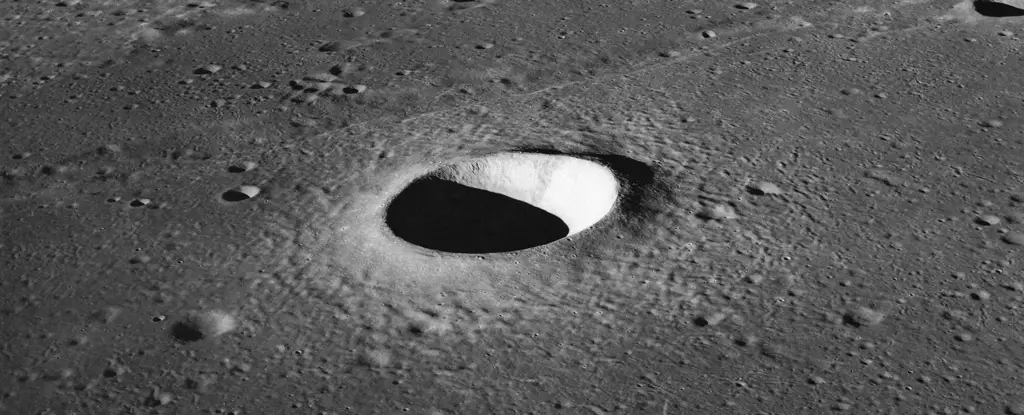The Moon, Earth’s celestial companion, carries the striking imprint of cosmic violence across its surface. Unlike the dynamic and ever-changing landscapes of our planet, the Moon’s terrain has remained virtually eternal, a testament to the violent history of our Solar System. The abundance of impact craters—with some reaching staggering diameters of over 1,000 kilometers—narrates a saga millions of years in the making. The Late Heavy Bombardment, a period around 4 billion years ago, marked a significant chapter where our inner Solar System was bombarded by a cocktail of asteroids and comets. Consequently, these craters serve as time capsules, preserving the Moon’s tumultuous past while enabling us to glimpse into the formative years of our cosmic neighborhood.
An intriguing aspect of this preservation is the absence of an atmosphere on the Moon, which negates the processes of weathering, erosion, and tectonic activity that continually shape Earth. This stark difference allows lunar surface features to remain largely intact, creating a valuable record for scientists and historians alike. Each crater encapsulates a story of collision, revealing critical insights about the formation and evolution of planetary bodies, and ultimately, contributing to our understanding of how life on Earth has come to be.
The Cosmic Exchange: Material Transfer Between Moon and Earth
Amidst this backdrop, the dialogue between the Moon and Earth takes on profound significance. During the formation of craters, significant quantities of lunar material are ejected, achieving speeds that enable them to escape the Moon’s gravitational grip and reach Earth. This cross-pollination of debris between the two celestial bodies opens a window for researchers to understand the mechanisms at play in our Solar System. A recent paper published by a research team led by Jose Daniel Castro-Cisneros harnesses cutting-edge computer modeling techniques, marking a leap forward in our exploration of lunar ejecta.
Unlike previous studies, this research utilizes advanced simulation models, improving upon traditional methods to track how lunar debris makes its journey to Earth. By examining a broader set of initial conditions over extended periods, the team has significantly enhanced our understanding of how much lunar material eventually collides with our planet. This meticulous approach aims to unravel the connection between lunar ejecta and Earth’s impact timeline, helping us grasp how such events have shaped both life and geology on our planet.
Cutting-Edge Simulations and Findings
The researchers employed the REBOUND simulation package to simulate the trajectories of lunar ejecta over a staggering 100,000 years. This method, characterized by real-time modeling of both the Moon and Earth, offers an unprecedented level of detail. By recording data at five-year intervals, the study effectively delineates the critical moments when lunar material finds its way back to Earth. Their results unveil that approximately 22.6% of ejected lunar material collides with Earth over the century-long span, with half of these impacts occurring remarkably within the first 10,000 years of ejection.
Furthermore, the study highlights a nuanced understanding of how the Moon’s rotational dynamics influence impact probabilities. Ejecta launched from the Moon’s trailing side demonstrated a significantly higher likelihood of striking Earth, whereas materials ejected from the leading side showed far lesser probabilities. Additionally, the data revealed that lunar materials typically approach Earth at speeds ranging from 11.0 to 13.1 kilometers per second, predominantly impacting near the equator and exhibiting a fascinating trend of symmetrical distribution between the morning and evening hours.
Unraveling Mysteries: Implications for Near-Earth Objects
The implications of this research stretch beyond mere academic curiosity. By enriching our comprehension of the interplay between the Moon and Earth, it contributes invaluable insights on near-Earth objects (NEOs) like Kamo’oalewa, believed to be a fragment of the Moon itself. Understanding the origins and trajectories of such bodies holds significance for planetary defense strategies as humanity increasingly contemplates threats from space.
Not only does this study unearth crucial data on lunar-ejecta, but it also sheds light on the patterns of impacts throughout Earth’s history. The refined understanding of how moon rock and debris migrated to Earth adds an essential chapter to our overarching narrative around life and its evolution on our planet. The shared history between the Earth-Moon system, characterized by mutual exchanges, underscores how interlinked our existences are with cosmic events spanning billions of years. In a sense, we are not only residents of Earth, but also ‘children’ of the Moon—shaped by its ancient energies and stories, echoing across space and time.


Leave a Reply